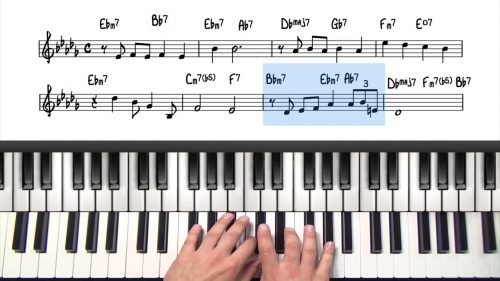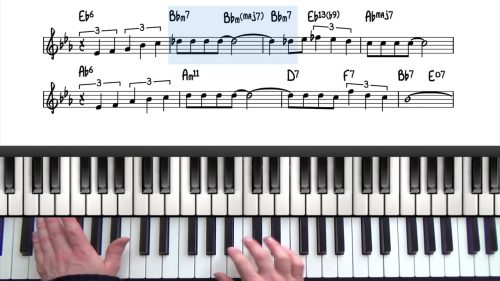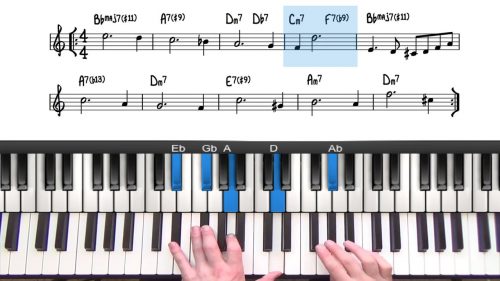Body & Soul Jazz Piano Tutorial Part 2
In part 2 of this tutorial, we play through the form again and add some bigger 2 handed chord voicings.
We build upon the left hand voicings that we covered in part 1 so make sure that you can play those voicings and melody accurately and in tempo before moving onto the more advanced chords in this lessons.
In the full arrangement, we incorporate extended and altered harmony, upper structure triads, and some interesting applications of diminished harmony.
Practice Tips
-
Body & Soul is a tricky jazz standard to play and this is quite an advanced arrangement.
-
Spend some time to analyse and understand the chords and voicings.
-
If you like the sound of a particular voicing, memorise it in terms of scale degrees and than apply it to another tune.
-
The more times you apply the same voicing, the deeper your understanding will become until you have completely internalised the shape, sound and application of the voicing.







Hi Hayden, I was wondering what the ” rule” is regarding the names of the accidentals in alterations and extensions. I don’t imagine they are just used interchangeably ? In the video above, you mention that F#min7 is part of a D major chord, and you are displaying Db and Gb, instead of C# and F#. Are we still working with scale degrees here ? Many thanks for your help :)
Hi Natasha!
Good question.
This is partly due to poor editing on my behalf, and also because this tune modulates through many keys.
In all of my earlier lessons – this is one of them – I set the light up keyboard to always show flat accidentals ie. Db, Eb, Gb, Ab etc… instead of C#, D#, F#, G# etc…
Most jazz standards are written in ‘flat keys’ such as F, Bb, and Eb, and so this worked well most of the time.
However, in tunes like this, where the harmony modulates, it displays the incorrect enharmonic equivalents.
For the bridge of this tune, the harmony moves to the key of D Major and the keyboard is showing Db and Gb, instead of C# and F#.
Since meeting Hugh – our editor that helps out with the increased editing workload – he found a brilliantly clever way to record both #’s and b’s and then we can pick between them in the editing stage to ensure we show the correct enharmonic equivalent. So you won’t see this issue in the newer lessons.
Ultimately, it is the correct note, just spelt wrong relating to the key. This will always be for sharp keys as outlined above. For flat keys, most of the time it will show the correct enharmonic equivalents.
My recommendation would be to always think numerically, try to not to overanalyse the black note name bar.
I’d recommend copying the voicing, and then immediately looking down at your hands on the piano and saying to yourself “we’re in the key of D Major” perhaps play the scale, then work out the individual notes of the voicing from the scale in terms of scale degrees. That way we are working on our recognition/knowledge of numeric harmony.
I hope all that makes sense Natasha, if you’d like me to elaborate on anything just let me know.
Cheers,
Hayden
Hi Hayden,
As it is mentioned there will be a follow up lesson that focusing on improvisation, I am unable to find the link. Is it not available yet or just me unable to find it (please kindly provide in that case)?
Cheers,
Hi Peerapong 👋🏻
Yes this lesson has not yet been created.
We do have some jazz standard improvisation studies in this course: pianogroove.com/jazz-piano-lessons/how-to-improvise/ – but I’m unsure how helpful these are at teaching improvisation.
My main recommendation would be compile a list of recordings of this tune and transcribe the parts of the improvised sections that you like, using just your ears.
Transcription is a very important exercise for students and we have many transcription studies in the forum to help students get started with this:
pianogroove.com/community/c/improvisation-exercises/30
We could create an improv tutorial on Body & Soul in the future. Perhaps take a look at the lessons in the course referenced above, and let me know if you think this style of tutorial would be helpful.
My main recommendation Peerapong would be to go ‘straight to the source’ and learn directly from your favourite improvised solos over Body & Soul. It is difficult to begin with, but I can say with certainty that this is the most time effective way to improve at improvisation.
Let me know if that helps and any more questions let me know.
Cheers,
Hayden
Thanks Hayden, Its just my curiosity to know what the advanced ‘arrangements’ look like, while I still at this stage memorizing the basic chords. Will definitely look at the lessons you recommend (hopefully in the near future)
Hello,
at 9:45, I notice that you play a Bb major 9 instead of a Bb minor. Is there any reasoning behind why it is played as such?
Hi Jose 👋🏻
Good question.
The chord there is a Bb-7 and so that was a mistake on my behalf. Apologies for the confusion there.
We have a more advanced lesson on that exact section where we explore some interesting tritone substitutes, check it out here:
pianogroove.com/jazz-piano-lessons/advanced-tritone-substitution/
Check out the reharmonisation for those last 2 measures of the A Section which we cover in chapter 2.
Any other questions let me know and enjoy the lessons!
Cheers,
Hayden
Hi Hayden,
I thought I understand upper structures, but I’m already confused by the opening line, when you harmonize the melody with an F dimished triad. Why is this the right chord to use here, besides it being so close to that Bb7?
Many thanks!
Hi Theo,
We could look at the F diminished triad as the 5-b7-b9 of Bb7.
We could also play that Bb7 with root and b7 in the left hand, and then a B diminished triad in the right hand which gives us b9-3-5.
But we don’t have to view those 3 notes as a B dim triad if it is easier to just see the b9, the 3rd, and the melody.
Sometimes we can fall into the trap of over analysing a chord.
I’d recommend to go with whichever approach is more logical for you.
For upper structures, I find that the 4 common upper structures on the cheat sheet are more than sufficient to meet my needs for colour and tension over dominant chords, and I have not tried to learn all of the possibilities of diminished and augmented triads superimposed over a dominant chord.
From looking into it briefly it is an area of study, but for myself the time vs reward did not add up when I’m already happy with the ‘colour palette’ from the 4 major triads on the Upper Structure Cheat Sheet.
Here to help if you have any other questions.
Cheers,
Hayden
Hello Hayden:
Did I get this intro to Body and Soul from you or elsewhere on the Pianogroove portal:
Bbm7 A7#11 // Eb Ab13 // Dbmaj7 // Fm 11 Bb7#5#9 //
Melodically, it sounds fine to me; theoretically, it seems unusual. I am looking for an explanation behind the chords, that’s why the question.
Thank you kindly. Smole
Hi Smole 👋🏻
I hope you are well.
Yes that is a lovely intro and in fact those chords are the same as the final 2 bars of the A section, so we are simply utilising the harmony from the tune and repurposing it as an intro.
Bb-7 to A7 is a 25 progression but A7 is the tritone sub. We add the #11 on top to keep the melody intact.
We then have a 251 to Db Major (the key of the tune) … Eb-7 / Ab7 / Dbmaj7. We could also play Eb-7 / D7 / Dbmaj7 to substitute the V7 chord for its tritone. Also adding a #11 on that D7 is nice by playing a 2nd inversion E Major Triad over the D7 in the left hand.
The final 2 chords are the 3 and 6 in the key of the Db Major (the key of the tune). The 3 chord is the F-7 but we can play this as an F-11b5, and then the Bb7alt chord with the #5#9 alterations. This works because the tune starts on the 2 chord (Eb-7 in the key of Db) and so the F-11b5 and Bb7 creates a 251 to Eb-7 to start the tune.
Basically we are just playing around with the diatonic chords of Db Major, and also adding some tritone substitutions and other alterations such as the F-11 with the b5, and the altered tones over the Bb7.
Hope that helps and have fun with this progression!
Cheers,
Hayden
Thank you, Hayden; of course this clarifies things for me especially the chord substitutions (tritone especially). I am amazed that I did not notice this intro as the last two bars from part A but will be more careful in the future not to miss things (especially because you routinely explain everything clearly during the lessons).
And I will continue to have fun with this whole course since it is continually upgraded.
Best, Smole
Hi, Hayden, at the 4:28 mark on the video when you use the Herbie Hancock voicing, it seems you are using your right hand thumb to play both the Gb and Ab at the same time. Is this correct?
For some chorts the Herbie Hancock voicing can be tough on the fingers.
Hi Humberto,
Yes the ‘2 notes with the thumb’ fingering is correct and it’s the most efficient and ergonomic fingering to use in most keys.
The are 4 keys where this fingering is difficult, those keys/chords are: C-11, C#-11, G-11, and Ab-11 …. in these keys we can play the minor 3rd with our RH thumb, and the 11 with our RH index finger – but this can be a stretch.
For all other minor 11 chords using this voicing, I play both the minor 3rd and 11th with my right hand thumb and I find this to be the most comfortable position.
Please see our dedicated lesson on this chord voicing: pianogroove.com/jazz-piano-lessons/herbie-hancock-voicing/ – and in particular see the final chapter “Chromatic Practice Drill” where we move the chords up and down chromatically. That’s a useful drill.
For the ‘4 tricky keys’ highlighted above, here are some variations:
Firstly, we can move the 11th/4th into our left hand, so for C-11, the left hand plays C-F-Bb and the right hand plays Eb-G-Bb-D. That’s a nice voicing.
Also try this voicing for C-11 which is one of my favourites:
Left hand: G-C-Eb
Right Hand: F-Bb-D
We can see this as a 2nd inversion C- triad in the left hand, and a 2nd inversion Bb major triad in the right hand. The only difference between this and the original voicing is that the C in the left hand has moved up an octave, but now we play 3 notes in each hand, instead of 4 notes in the right hand and 2 in the left.
I hope that helps and have fun with these voicings!
Talk soon,
Hayden
Thanks, Hayden, for your always very thorough and helpful replies.